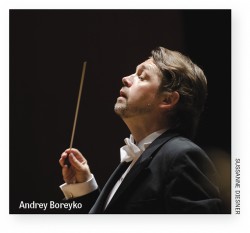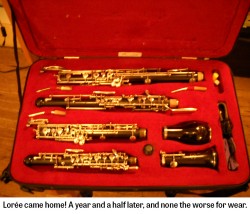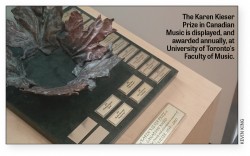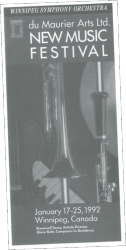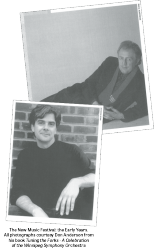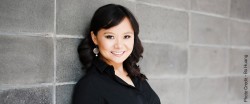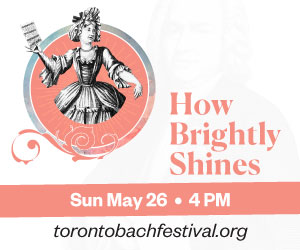Monumental Milestones: Anticipating “Babi Yar”
“It’s an amazing work and I have been nervously and excitedly awaiting this performance all year, since I heard about it, in fact,” says Beckwith. “But I am still wondering whether it’s going to live up to expectations – not the music itself or the orchestra, they are marvellous, but wondering if, and how, it can really connect with our audience. It’s not enough just for it to be done. It deserves to be done right.”
Parsing what “done right” means to Beckwith in this case is a rigorous exercise. It means, for one thing, assertive outreach to the communities that should be there to witness it, because it is part of their collective history. It means rising adequately to the challenge of assembling an adequate chorus of authentically Russian-sounding basses (“the bass soloist’s cheering section” as Beckwith describes them), so that they are sonically on the same page as Bolshoi-trained bass soloist Petr Migunov. It means ensuring that the TSO, and all concerned, understand the historical importance of using Yevtushenko’s original uncensored texts. It means program notes that address what the monumental work meant in its own time (no easy task, in a part of the world where people’s histories often lie buried at different depths in the same piece of land). And perhaps the greatest challenge of all, it means trying to figure out how to enable “our audience,” most of whom will not understand the language being sung, to immerse themselves fully in a work of art whose universal truths are so completely grounded in the particular.
So let’s back up a bit, shall we? Fortunately there’s a good starting point for all this in The WholeNote itself – a review written by columnist Bruce Surtees in October 2014 of a Praga SACD release of a recording of the very first performance of this work. Here’s what Surtees wrote:
On December 18, 1962, defying admonitions from Premier Khrushchev and the Soviet Presidium, the first performance of Shostakovich’s Thirteenth Symphony was given in Moscow and dutifully ignored by the press. The composer had set five of Yevgeny Yevtushenko’s poems, including the recently published Babi Yar, the subject of which was anti-Semitism and the well-documented, wholesale massacre of Jews in Kiev by the Nazis in WWII. Further performances were banned until Yevtushenko altered the text, which he did, but not before December 20 when there was a repeat performance with the original text…with Kirill Kondrashin conducting the Moscow Philharmonic, two choirs and Vitaly Gromadsky, bass and speaker…More than a performance, this is a declamation. I know of no other recorded performance to come even remotely close to the intensity and impact of this significant and valuable document.
“It’s a piece I’ve had a hankering to be connected to ever since then,” Beckwith explains. “I was an exchange research scholar in the Soviet Union, way back in the 60s. In fact I arrived a month after the first performance of this symphony. It was in Moscow on December 18, 1962, and I arrived in January of 63. As part of the official academic exchange, since my topic had to do with Russian choral culture, I was attached to the choral department of the then Leningrad, now St. Petersburg, Conservatory and I soon found out that the choir of the school was looking forward to participating in the Leningrad premiere of the work – one of the most unusual choral works ever, written entirely for Russian basses and being a bass myself I was assured that I would be asked to join the chorus! It was tremendous, unexpected, the highlight of my stay in the Soviet Union.
“Except unfortunately the performance never took place.”
In Beckwith’s view the fact of the work falling into instant disfavour and the resultant censorship was all about the words, not the music. “Of course it was all about the poem in this case, not the music. Although I suspect musical censorship in Russia at least, and probably elsewhere, is usually about the words. In this case, of course the words are the music. The music exists only powerfully to project the words.”
As Beckwith explains it, the spark for the work was Shostakovich reading Yevgeny Yevtushenko’s recently published poem Babi Yar. “It starts with this very powerful statement, ‘On Babi Yar, there are no monuments’.”
The “no monuments” remained true until 1976, Beckwith says, but not for want of trying. “It’s not true that no attempts were made,” he says. But there was no agreement as to what exactly should be said.
From that one poem, and then others by Yevtushenko, “at some point Shostakovich went on to say why don’t I make this into a larger work, which at some point he decided to call a symphony.”
“If not a symphony, what would you call it?” I ask.
“I would call it a civic oratorio,” he says “although even that…a cantata, maybe…or something like that. It’s for a powerful, male, no-nonsense singer to deliver the text backed up by a cheering section. The choir is really his support – his cheering section. Occasionally taking part in some of the events being recounted they become participants briefly. But most of the time commenting, echoing or reinforcing what the singer is saying. The whole idea is to say this is ‘the people’ talking through the singer.”
It’s important to Beckwith to convey that even though that poem was the spark for the work, it was only the springboard. There are in fact five movements, each based on a separate poem, and each encapsulating a different facet of life in the Soviet Union so recently out of the Stalinist doghouse.
“The second movement is Humour – humour after the Holocaust, now there’s the opera composer’s sense of timing! Then there’s At the Store, anchored in the realities of postwar life, particularly women’s life; then there’s Fears, the poem that Shostakovich asked Yevtushenko to write for the emerging work. ‘Fears are dying in Russia’ it says, and catalogues them (although it goes on to list some that are a little newer, perhaps blunting the idea that they are all dying.”
“And the fifth?” I ask.
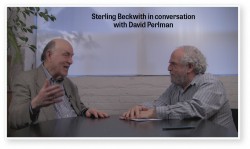 “The fifth, Career, is wonderful capstone about careerism” he says. “About the great careers of men of science and daring who risk all, including opprobrium, persecution etc. to stick to their guns, Galileo for example. And they are contrasted with the apparatchiks and sellouts, careerists who flourished through the Stalin era, and just as completely today in Moscow…and Washington, I dare say, and, who knows, just maybe even in Toronto.”
“The fifth, Career, is wonderful capstone about careerism” he says. “About the great careers of men of science and daring who risk all, including opprobrium, persecution etc. to stick to their guns, Galileo for example. And they are contrasted with the apparatchiks and sellouts, careerists who flourished through the Stalin era, and just as completely today in Moscow…and Washington, I dare say, and, who knows, just maybe even in Toronto.”
As for Beckwith’s checklist of what “done right” will mean, there’s room for cautious optimism on some fronts. The Elmer Iseler Singers and Amadeus Choir bass sections are the core of the bass cohort, with Beckwith and Iseler/Amadeus conductor Lydia Adams working closely together, using Beckwith’s system of transcription (another lifelong passion of his) to enable English speakers to get the sound of the Russian words right. “She reached out to me,” he says, “which was great, or I would have been after her to do it!”
Recruitment of other singers is under way, although it remains to be seen whether Beckwith’s healing vision of a bass cohort made up of singers from the Russian, Ukrainian and Jewish communities can be realized. All concerned are now aware of the nuances of which texts get used. And as for enabling “our audience,” most of whom will not understand the language being sung, to immerse themselves fully in a work of art whose universal truths are so completely grounded in the particular, well we will all have our part to play in that as the next six weeks unfold.
David Perlman can be reached at publisher@thewholenote.com


